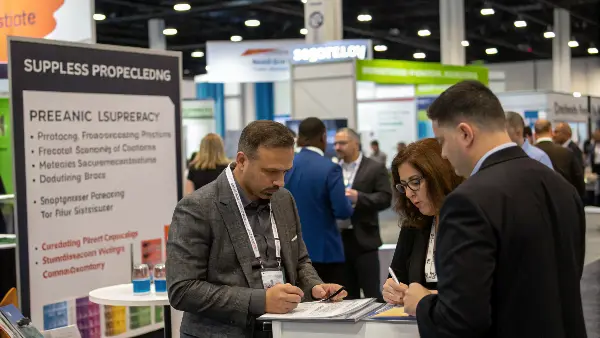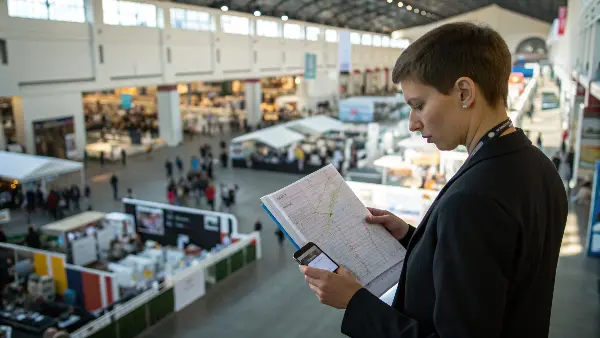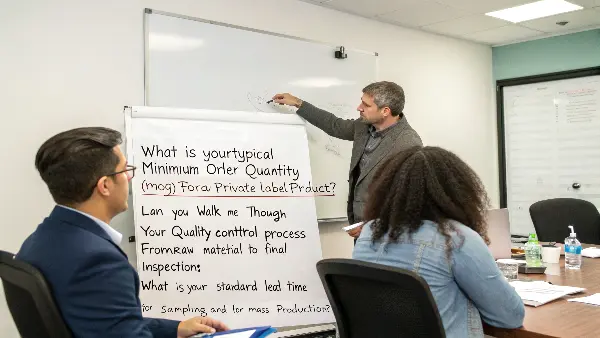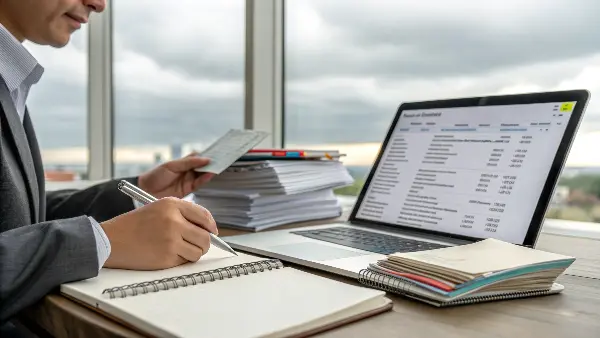Trade shows are a huge investment of time and money. It’s easy to get overwhelmed by the noise and return empty-handed. But what if you could cut through the chaos and find the perfect private label partner? A solid plan is your key to success.
To maximize private label opportunities at a trade show, you must prepare strategically. Start by researching exhibitors and setting clear goals before you go. During the show, focus on vetting suppliers by examining their product quality and asking targeted questions about their manufacturing process. After the show, follow up promptly and systematically to build on the connections you made. This ensures you find a reliable partner and get the best return on your investment.

Walking onto a trade show floor without a plan is like navigating a maze blindfolded. You might stumble upon something good by chance, but you’re more likely to get lost, waste precious time, and miss the manufacturers who could truly elevate your brand. I’ve seen it happen many times. The most successful brand owners I know are the ones who treat a trade show not as a shopping trip, but as a strategic mission. It all begins long before you pack your bags.
What Pre-Show Preparation Is Essential for Finding the Right Private Label Partner?
You plan to attend a major adult product trade show, expecting to find great new suppliers. You arrive, grab a map, and are immediately overwhelmed. Booths blur together, and every supplier is busy. You feel you are falling behind before you even start.
Effective pre-show preparation is your most critical tool. Start by studying the exhibitor list weeks in advance. Identify potential manufacturers that align with your brand’s quality and product needs. Then, schedule meetings with your top choices before the show even starts. Create a list of specific goals, questions, and product ideas you want to discuss. This preparation transforms you from a passive attendee into a strategic buyer with a clear mission.

Success at a trade show is determined before you even step on the plane. I learned this the hard way during one of my first trips to an international expo. I showed up with a vague idea of "finding new products" and spent most of my time wandering aimlessly. I came home with a heavy bag of brochures and no meaningful connections. Now, my process is entirely different. It’s a structured approach that ensures I leave with actionable leads for partners like PrivyPlay.
Define Your Objectives
First, you need to know exactly what you are looking for. Are you trying to source a specific new product? Do you need a manufacturer for a custom design you’ve developed? Or are you looking for a backup supplier to improve your supply chain resilience? Your goals will dictate your entire strategy.
| Objective Type | Key Actions to Take |
|---|---|
| Source a New Product | Research exhibitors known for innovation in your desired category. Review their online catalogs. |
| Find a Custom (OEM) Partner | Look for manufacturers that explicitly advertise OEM/ODM services. Check their experience and case studies. |
| Secure a Backup Supplier | Identify established manufacturers with a reputation for reliability and consistent quality. |
| Market Research | Plan to visit a wide range of booths, including competitors and newcomers, to understand trends. |
Research and Shortlist Exhibitors
Once your objectives are clear, get a copy of the exhibitor list from the trade show organizers. This is your treasure map. Go through it line by line. Visit the websites of potential partners. Do they match your brand’s aesthetic and quality standards? Do their listed capabilities (e.g., silicone molding, electronics) match your needs? Create a tiered list: ‘A’ for must-see companies, ‘B’ for promising options, and ‘C’ for maybes.
Schedule Meetings in Advance
The best suppliers are always busy. Their schedules fill up weeks before the show. Do not wait until you arrive to try and talk to them. Send a professional email to your ‘A’ list contacts. Introduce your brand, explain what you are looking for, and request a specific meeting time. This shows you are serious and respects their time. It guarantees you will have a focused conversation away from the noisy aisle.
How Do You Effectively Vet Potential Suppliers on the Trade Show Floor?
You’ve scheduled a meeting with a potential supplier and their booth looks impressive. The products on display are shiny and the salesperson is charismatic. It’s easy to get caught up in the presentation and accept their claims at face value.
To truly vet a supplier, you must look beyond the sales pitch. Start by physically examining their product samples. Feel the materials, check the seams, and test the functions. Ask direct questions about their quality control process and certifications. Observe how their team communicates with you. Are they knowledgeable and transparent? A reliable partner will be able to answer detailed questions confidently and provide evidence of their capabilities.

A fancy booth and a smooth presentation don’t guarantee a quality manufacturer. I’ve seen beautiful displays hiding subpar products and disorganized operations. The trade show floor is your chance to play detective. The clues to a great partner are right there in front of you, but you have to know where to look. Your goal is to separate the professional operators from the purely promotional ones.
First, Assess the Product
Don’t just look at the products; interact with them.
- Material Feel: Pick up the samples. If it’s a silicone toy, does it feel silky and premium, or is it tacky and oily? A low-quality silicone can be a sign of cheap fillers.
- Build Quality: Look at the seams and joints. Are they clean and seamless, or can you see glue marks and uneven edges? For electronic toys, check the charging port. Is it well-integrated or does it look like an afterthought?
- Functionality: Ask to turn the product on. Do the buttons feel responsive and solid? Do the vibration patterns feel powerful and distinct, or weak and generic? A good manufacturer invests in quality motors and components.
Second, Evaluate the Team
The people you talk to are a window into the company’s culture.
- Expertise: Can the person you’re speaking with answer technical questions about materials, production timelines, and MOQs? Or do they have to constantly ask someone else? You want to work with a team that knows their business inside and out. At PrivyPlay, we make sure our trade show staff are experienced project managers, not just salespeople.
- Communication: Are they listening to your needs, or are they just delivering a canned sales pitch? A good partner will ask you questions about your brand, your customers, and your goals. Their English proficiency and responsiveness are also good indicators of how easy communication will be down the line.
Third, Look for Proof
Claims are easy to make, but a great supplier will have evidence to back them up. Ask to see their certifications, like ISO, CE, or RoHS. These documents prove they adhere to international quality and safety standards. Ask about their factory. Do they own it, or are they a trading company? While trading companies can be useful, working directly with a factory often gives you more control and better pricing for private label products.
What Key Questions Should You Ask Potential Manufacturers?
You have a good feeling about a supplier, but "feelings" don’t build a successful business. You need facts. It’s easy to ask simple questions like "What’s the price?" but this barely scratches the surface and won’t protect you from future problems.
Go beyond price. Ask detailed questions about their operations to reveal their true capabilities. Key questions include: "What is your typical Minimum Order Quantity (MOQ) for a private label product?" "Can you walk me through your quality control process from raw material to final inspection?" and "What is your standard lead time for sampling and for mass production?" Their answers will tell you if their process aligns with your business needs.

Asking the right questions is a skill. It’s how you move from a superficial chat to a deep analysis of a potential partner. I carry a checklist of questions to every meeting. It keeps me focused and ensures I get the same core information from every supplier, which makes comparison much easier later on. These questions are designed to uncover potential red flags related to quality, capacity, and communication before you commit to anything.
Here are the essential questions you should be asking, broken down by category:
Manufacturing and Capacity
These questions help you understand their production capabilities and if they can scale with your brand.
- Do you own your factory or are you a trading company? This is fundamental. Working directly with a factory like ours gives you better control over the final product.
- What is your production capacity per month? What is your current utilization? This tells you if they have room to take on your orders and if they can handle sudden increases in demand.
- What is your standard lead time for a new custom sample? And for mass production after a sample is approved? Their answer reveals a lot about their efficiency. Long lead times can kill your sales momentum.
Quality Control and Compliance
This is where you dig into their commitment to quality, a non-negotiable in the adult products industry.
- Can you describe your QC process? How many inspection points are there? A good manufacturer will describe a multi-stage process, including checks on raw materials (IQC), during production (IPQC), and on the final product (FQC).
- What certifications does your factory and your products have (e.g., ISO 9001, CE, RoHS, UKCA)? Ask to see the documents. This shows they are serious about safety and global standards.
- How do you handle product defects or returns from a client? A transparent partner will have a clear process for addressing issues, not just dismiss the possibility.
Partnership and Logistics
These questions explore what it’s actually like to work with them day-to-day.
- What are your MOQs for private label products? Is there flexibility for new partners? We at PrivyPlay understand new brands need a start, so we often support lower MOQs.
- Who will be my main point of contact? What is their role and experience? You want a dedicated project manager who speaks your language fluently and can solve problems.
- What are your payment terms for new clients? This is a practical question that helps with your financial planning.
What Are the Critical Follow-Up Steps After the Trade Show Ends?
The trade show is over. You fly home with a pocketful of business cards and a notebook full of ideas. It feels like a success, but the momentum fades. Emails go unanswered, and those promising conversations turn into cold leads. The real work was lost in the follow-up.
The most critical follow-up step is to act quickly and systematically. Within 48 hours, send personalized emails to your top-tier contacts, referencing your conversation to jog their memory. Organize your notes and contacts in a spreadsheet, ranking them by priority. For your most promising leads, immediately request samples and detailed quotes to keep the momentum going. This transforms your efforts from a meet-and-greet into the start of a real business partnership.

The days immediately following a trade show are more important than the show itself. This is where deals are won or lost. I treat my post-show follow-up with military precision because I know my top prospects were also talking to my competitors. Speed, personalization, and clarity are everything. You need to remind them why your brand is the one they should partner with.
Organize and Prioritize Your Leads
Before you do anything else, organize your notes. Don’t rely on memory. Create a simple spreadsheet with columns for the company name, contact person, your priority ranking (A, B, C), key discussion points, and next actions.
- Tier A: Your top 3-5 prospects. These are the companies you had great meetings with and who align perfectly with your needs. They are your first priority.
- Tier B: Promising leads who meet most of your criteria. They are worth pursuing but are second in line.
- Tier C: Companies that were interesting but not a perfect fit. A simple thank-you email is sufficient for now.
Send Personalized Follow-Up Emails
Do this within 24-48 hours. A generic "nice to meet you" email will get deleted. Your email must be specific.
- Subject Line: Make it clear and easy to find. For example: "Follow-Up: [Your Brand Name] & [Their Company Name] from X-BIZ Expo"
- Personalization: Start by referencing a specific detail from your conversation. "It was great discussing your new silicone dual-motor vibrator at your booth on Tuesday." This shows you were paying attention.
- Clarity: State your purpose clearly. "As discussed, I would like to move forward with the next step. Could you please provide a quote and sample for [Product X]?"
- Call to Action: End with a clear next step. Examples include "Please send the quotation by this Friday" or "Let’s schedule a brief 15-minute call next week to discuss details."
Request Samples and Quotes
For your Tier A leads, don’t wait. Immediately move to the next stage. Ask for physical samples of the products you discussed. You need to validate the quality you saw at the show. At the same time, request a formal quotation (RFQ) that includes pricing at different quantities, lead times, and payment terms. This concrete information is what you need to make a final business decision. A serious manufacturer will respond to these requests quickly.
Conclusion
Maximizing a trade show is not about luck; it’s about strategy. With focused preparation, disciplined vetting on the floor, asking the right questions, and diligent follow-up, you can turn an overwhelming event into a goldmine of private label opportunities for your adult product brand.
